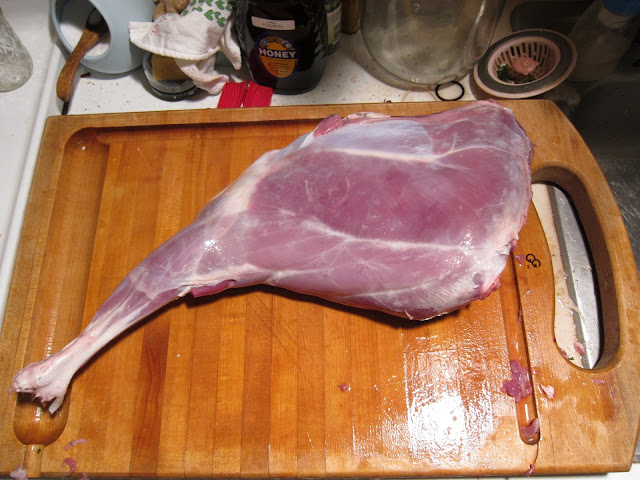Like most butchers, my butcher charges a flat-rate fee per deer. In this case, $65 per deer for the basic cuts. If the deer weighs 40lbs, it costs $65. If it weighs 240lbs, it still costs $65.
The first deer I took to the butcher this year yielded 50lbs of processed meat, so a little more than a dollar per pound. I can live with that. But the last deer I killed barely weighed 50lbs dressed (i.e. with the guts removed), and I just couldn't justify taking it to the butcher for that price and the meat it would yield.
If I had a garage, I would simply process it myself. But I don't. And I don't think my neighbors or landlord would appreciate me hanging a deer in the yard. Still, I wasn't about to pay $65 to have it processed.
After a consulting a friend, we decided to take it to his friend's farm, quarter it, and then process the quarters in my apartment. He tried to convince me to do the whole process in his basement, but dragging a dead deer into an apartment complex in downtown Ithaca and butchering it in a communal basement just seemed like a really, really bad idea. So we drove out to his friend's place.
It was well past dark when we arrived. The barn, long ago abandoned, lacked lighting of any sort. With flashlights in hand we hung the deer from the rafters and began to strip the skin from the carcass. I'm sure from a distance it was a sight to behold: two guys skinning a dead animal hung from the rafters of an abandoned and darkened barn.
It has been nearly 15 years since I've last skinned a deer and to say I was a little rusty is an understatement. Worse yet, I have never quartered a deer before. Although my friend was slightly more experienced, he also admitted to not knowing exactly how to quarter a deer. I have heard nightmare stories about novices ruining the majority of the meat simply by making the wrong cuts. As we stumbled through the process, without much clue as to what we were doing, I worried we would be left with nothing more than a pile bones and a rotting carcass.
But persevere we did! in about an hour's time we had the deer quartered and loaded back into the truck, with each quarter resting in a game bag and then placed in a large cooler. At the apartment, I carried the cooler to the porch, made a run to the local grocery store for freezer paper and cling wrap, and returned back home just short of 10:00 PM. By 1030, I was ready to start cutting, only I had no real clue on how to go about doing it. So I started doing Google searches, piecing together information from websites, blog posts, and Youtube videos on how to process a deer.
It went better than expected, although it took much longer than I originally anticipated. I would bring in a section from the porch, unwrap it, and then Google something like "process front quarters deer," referring back to the webpage as much as needed. At 6AM, I put the last package in the freezer, cleaned up the kitchen, and laid down on the couch. I had a hunting spot reserved for that morning and I told myself I was only going to take a half-hour nap, but
it had been 25 hours since I last slept and I didn't wake till noon.
I did the back straps and rib cage first. It seemed to take forever and maybe yielded four, one pound packages--leaving me feeling ill once again for shooting the deer.
The shot must have hit the stomach because the entry and exit points in the rib cage were filled with half-digested stomach contents, leaving me unsure of what meat to keep. Ultimately, I played it safe. If it smelled bad, I threw it in the scrap bin.
I did the front quarters next. The bullet exited from one of the front shoulder (it was a quartering away shot). After reading some articles, I decided to keep everything whole as shank and roast. I figured this is the best use of the meat since the deer was so young and the meat would be tender. Plus, I don't have processing equipment.
The shank and roast from the front leg that was shot. I was able to piece everything out simply using the fillet knife shown and, in a few cases, some elbow grease. As you can see, the front legs didn't yield much either. At this point, I had determined to never again shoot another small deer.
I know it's not the biggest, but something changed in me when I lifted the back leg out of the bag and set it on the cutting board. It had a heft to it that the other parts were previously lacking.
After some Google searches, I determined the back leg should yield five roasts. Luckily for me I have some magic up my sleeve, because both back legs yielded about seven roasts a piece. That's fourteen roasts! I was only able to determine the sirloin, which I believe is at the bottom left. All the others are labeled "roast, top, round, chunk, etc."
All and all, not bad. I've finally learned how to overcome the spatial constraints that an apartment presents (answer: quarter it somewhere else!). And gained some processing confidence, too! It is pretty self-explanatory. Next time, I'll likely just debone the deer in the field and process it at home again. No sense paying the butcher if you can do it yourself.












